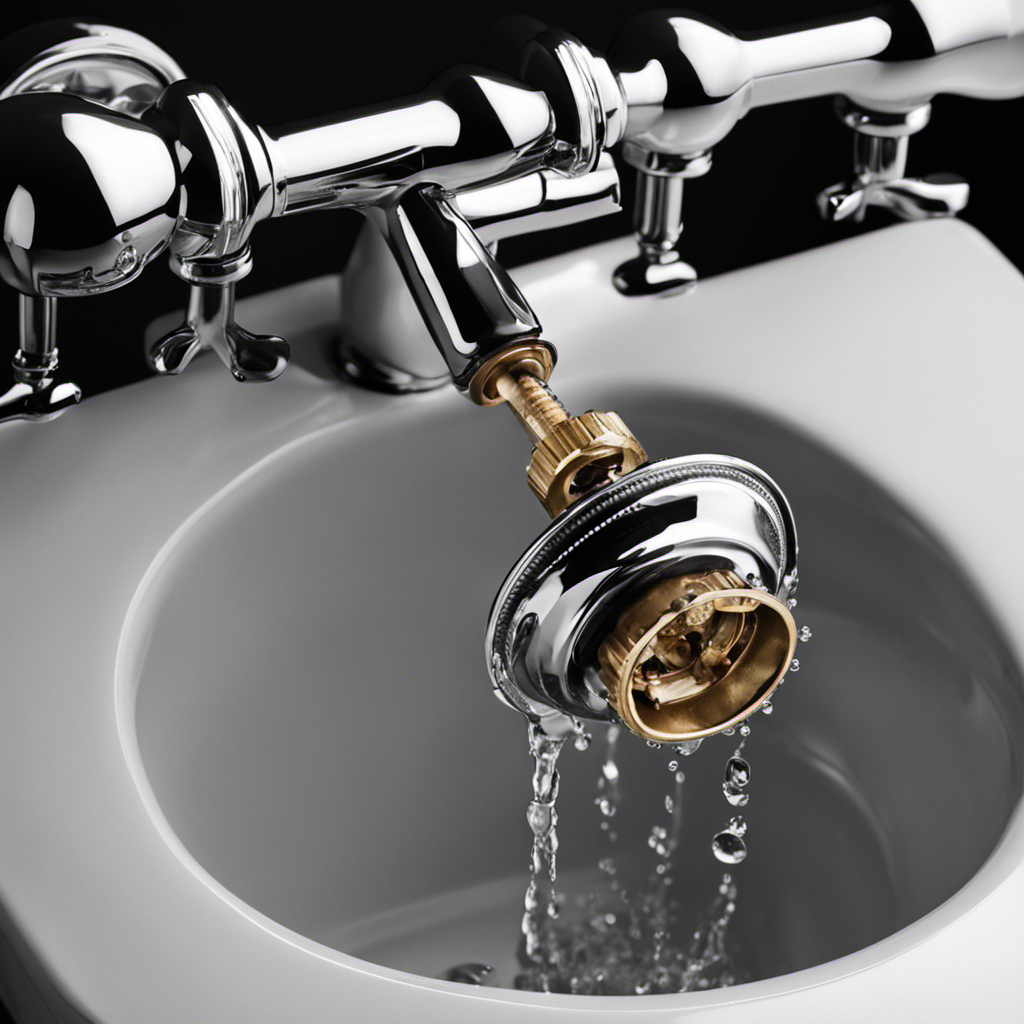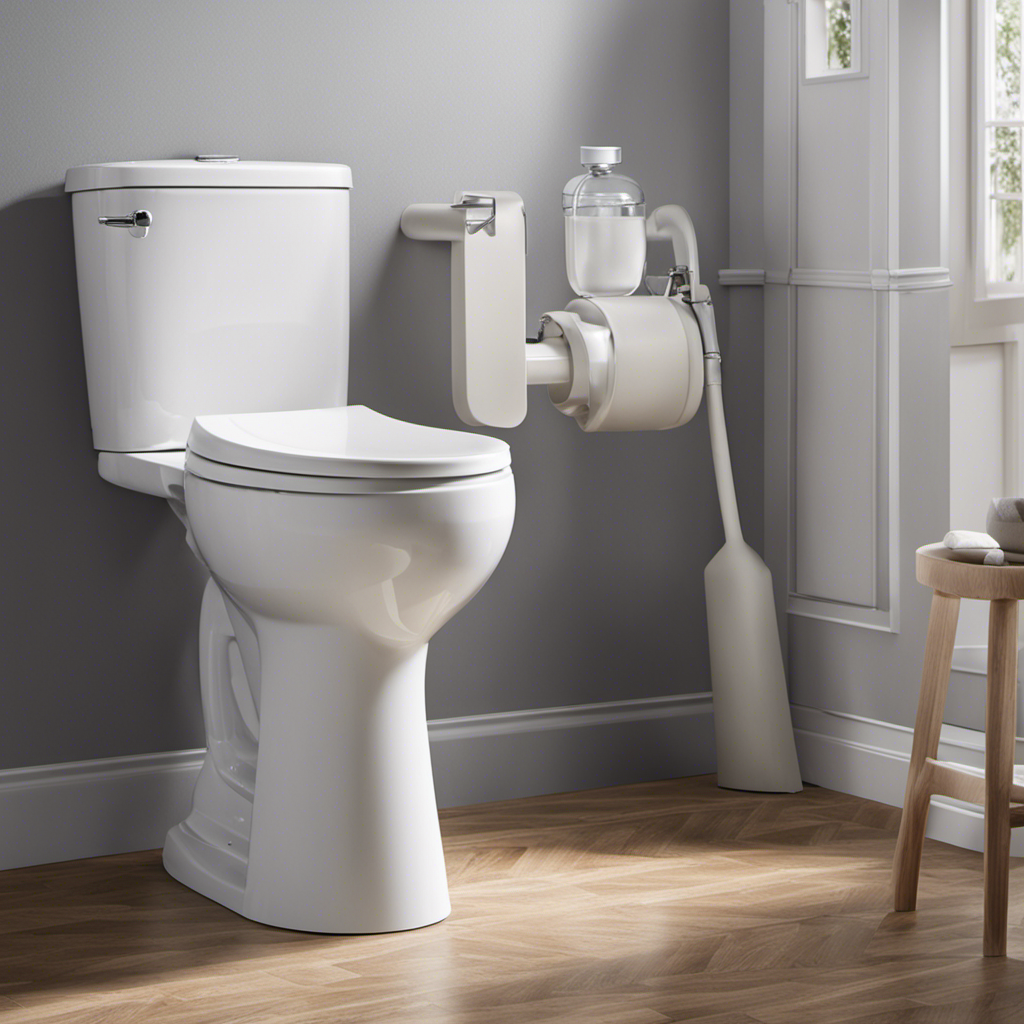Have you ever been frustrated by a constantly running toilet? Well, I certainly have. Luckily, I’ve learned a simple solution that can save you time and money.
In this article, I’ll show you how to fix a toilet fill valve. By following these step-by-step instructions, you’ll be able to assess the problem, gather the necessary tools, and confidently disassemble, clean or replace, and reassemble the fill valve.
Say goodbye to that annoying running sound and hello to a properly functioning toilet. Let’s get started!
Key Takeaways
- Check if the water level in the toilet tank is too low.
- Look for symptoms like a constantly running toilet or improper refill after flushing.
- Gather tools such as an adjustable wrench, screwdriver, pliers, bucket, towel, and replacement parts.
- Shut off the water supply by locating the shut-off valve near the base of the toilet or on the wall behind it and turning it clockwise until fully closed.
Assessing the Problem
First, check if the water level in the toilet tank is too low. Evaluating symptoms is the first step in identifying potential causes for a malfunctioning toilet fill valve.
If the water level in the tank is below the recommended level, it could indicate a problem with the fill valve. To assess this, remove the tank lid and observe the water level. If it is lower than it should be, it could be due to a faulty fill valve or a clogged water supply line.
Other symptoms to look out for include a constantly running toilet or a toilet that doesn’t refill properly after flushing. These indicators can help narrow down the potential causes of the issue.
Now that we have assessed the problem, let’s move on to gathering the necessary tools.
Gathering the Necessary Tools
When it comes to repairing a toilet fill valve, having the right tools is essential. In order to efficiently gather the necessary tools for the job, there are a few tips to keep in mind.
Essential Tools for Repair
You’ll need a few essential tools to repair a toilet fill valve. Proper maintenance and troubleshooting of toilet fill valves can help prevent costly repairs and ensure the efficient operation of your toilet. Here are the tools you’ll need:
| Tools | Description |
|---|---|
| Adjustable wrench | Used to loosen and tighten nuts and bolts |
| Screwdriver | Used to remove and install screws |
| Pliers | Used to grip and turn objects |
| Bucket | Used to catch water and prevent spills |
| Towel | Used to clean up any spills or messes |
| Replacement parts | Such as a new fill valve or flapper |
These tools will enable you to easily disassemble the fill valve, replace any faulty parts, and reassemble it properly. By following the correct procedures and using the right tools, you can successfully repair your toilet fill valve and ensure its efficient functioning.
Now that you know the essential tools required for the repair, let’s move on to some tips for efficient gathering of these tools and preparing for the repair process.
Tips for Efficient Gathering
To efficiently gather the necessary tools for the repair process, make a list of the required items and check them off as you collect them. This simple step can save you time and ensure that you have everything you need to fix your toilet fill valve.
Here are three essential items you will need:
-
Adjustable wrench: This tool will help you loosen and tighten nuts and bolts, allowing you to easily remove and replace the fill valve.
-
Screwdriver: A flathead or Phillips screwdriver will be necessary to remove any screws holding the valve in place.
-
Replacement fill valve: Make sure you have the correct replacement valve before starting the repair. This will ensure a smooth and efficient process.
Shutting Off the Water Supply
First, make sure that you’ve shut off the water supply to the toilet before attempting to fix the fill valve. Water supply management is crucial in preventing water leakage and ensuring the proper functioning of the toilet.
To shut off the water supply, locate the shut-off valve, usually located near the base of the toilet or on the wall behind it. Turn the valve clockwise until it is fully closed. This will stop the flow of water to the toilet.
It is important to shut off the water supply to avoid any potential flooding or water damage while working on the fill valve. By following this step, you can ensure a safe and effective repair of the fill valve without any water leakage.
Disassembling the Fill Valve
When it comes to disassembling a fill valve, understanding the valve components and their functions is crucial. This knowledge helps me approach the disassembly process with confidence and precision.
Additionally, knowing proper disassembly techniques ensures that I can efficiently and effectively remove the necessary components without causing any damage.
Valve Components and Functions
Check out the valve components and their functions to better understand how to fix your toilet fill valve. Here are the key components and their roles in maintaining and adjusting the water level:
-
Float: This buoyant device controls the water level in the tank. When the water level drops, the float lowers and opens the fill valve to refill the tank.
-
Fill Valve: This valve controls the flow of water into the tank. It opens when the float signals a need for more water and closes when the tank is filled to the desired level.
-
Adjustment Screw: Located on the top of the fill valve, this screw allows you to adjust the water level by raising or lowering the float.
Understanding these components and their functions is crucial for proper valve maintenance and adjusting the water level.
Now, let’s move on to the next section to learn about proper disassembly techniques.
Proper Disassembly Techniques
To properly disassemble the valve, start by removing the adjustment screw. This is a crucial step in toilet fill valve maintenance.
By following proper disassembly techniques, you can address common fill valve problems effectively. Begin by turning off the water supply to the toilet and flushing to empty the tank.
Next, remove the lid from the tank and locate the fill valve. Use a wrench to loosen the adjustment screw and detach it from the valve body.
Once the adjustment screw is removed, carefully unscrew the cap from the valve body, taking care not to damage any of the components. This will allow you to access the inner workings of the fill valve and address any issues that may be causing problems with the toilet’s water flow.
Troubleshooting Common Issues
One common issue that homeowners may experience is a slow or weak water flow in the tank. This can be frustrating, but there are troubleshooting techniques and DIY repair options available to fix the problem.
Here are three possible causes for the slow or weak water flow:
-
Clogged or blocked fill valve: Debris or sediment can accumulate in the fill valve, restricting the water flow. This can be resolved by cleaning or replacing the fill valve.
-
Low water pressure: If the water pressure in your home is low, it can result in a weak flow in the toilet tank. Check your water pressure and consider installing a pressure booster to improve the flow.
-
Faulty float valve: A damaged or improperly adjusted float valve can affect the water flow. Adjusting or replacing the float valve can help resolve the issue.
Cleaning or Replacing the Fill Valve Components
Start by cleaning or replacing the fill valve components to resolve any issues with the toilet’s water fill mechanism.
When troubleshooting a fill valve, it is important to first check for any debris or mineral buildup that may be affecting its performance.
To clean the fill valve, turn off the water supply and disconnect the fill valve from the water line. Rinse the valve thoroughly to remove any sediment.
If cleaning doesn’t solve the problem, replacing the fill valve may be necessary. To do this, turn off the water supply, drain the tank, and remove the old fill valve.
Install the new fill valve according to the manufacturer’s instructions. This should resolve any issues with the toilet’s water fill mechanism and ensure proper functioning.
Reassembling and Testing the Fill Valve
After cleaning or replacing the fill valve components, it is important to reassemble and test the mechanism to ensure proper functioning. Here are some steps to guide you through the process:
- Carefully align the fill valve with the corresponding holes in the tank and firmly tighten the locknut to secure it in place.
- Reattach the water supply line to the fill valve and ensure it is securely fastened.
- Turn on the water supply and check for any leaks around the fill valve and water supply line.
To test the fill valve, follow these methods:
- Fill the tank with water and observe the water level. The fill valve should automatically shut off when the water reaches the desired level.
- Flush the toilet and observe if the fill valve refills the tank properly and stops when the water level is reached.
Frequently Asked Questions
Can I Use Any Type of Cleaning Solution to Clean the Fill Valve Components?
Yes, you can use cleaning solutions to clean the fill valve components. However, it is important to use the proper maintenance techniques and follow the manufacturer’s instructions to ensure the best results and prevent any damage.
How Often Should I Clean or Replace the Fill Valve Components?
I clean or replace the fill valve components regularly to ensure proper functioning. It’s important to troubleshoot a faulty fill valve and look out for signs like constant running or low water pressure.
Can I Use a Wrench to Disassemble the Fill Valve?
Yes, you can use a wrench to disassemble the fill valve. However, it’s important to exercise caution to avoid damaging the valve. Additionally, be sure to use proper cleaning solutions for the valve components.
Is It Necessary to Shut off the Water Supply Before Disassembling the Fill Valve?
Yes, it is necessary to shut off the water supply before disassembling the fill valve. Safety is important, so wearing gloves is recommended. Leaving the water supply on can cause leaks and make the job more difficult.
How Do I Know if the Fill Valve Is Causing the Toilet to Continuously Run?
If the toilet is continuously running, it could be due to a faulty fill valve. Troubleshooting tips can help identify the issue, and a step-by-step guide can assist with replacing the valve.
Conclusion
In conclusion, fixing a toilet fill valve is a relatively simple task that can be done with a few basic tools and some patience. By following the steps outlined in this article, you can save money on a plumber and have your toilet working properly again in no time.
Remember, a leaking toilet can waste up to 200 gallons of water per day, so it’s important to address any issues promptly. Don’t let a faulty fill valve add to your water bill and environmental impact.










